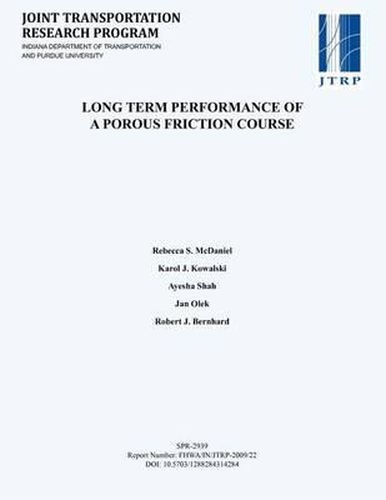Readings Newsletter
Become a Readings Member to make your shopping experience even easier.
Sign in or sign up for free!
You’re not far away from qualifying for FREE standard shipping within Australia
You’ve qualified for FREE standard shipping within Australia
The cart is loading…






In 2003, the Indiana Department of Transportation and the Federal Highway Administration allowed a test section of Porous Friction Course (PFC) to be placed on I-74 east of Indianapolis. The design, construction and early performance of that surface were compared to an adjacent SMA surface and a conventional Superpave HMA surface in a report prepared for the Institute for Safe, Quiet and Durable Highways. The early performance indicated that the PFC offered several advantages over the SMA and the conventional surfaces, including reduced tire/pavement noise, high friction and surface texture, and reduced splash and spray. There was a concern, however, that porous surfaces can lose their porosity, and therefore their performance advantages, over time. Consequently, the project summarized in this report was planned to continue monitoring the performance of the PFC and the comparison surfaces in order to investigate the durability of the porous surface over a five-year period (after construction). After five years under traffic, there have indeed been some changes in these properties. Most of the changes, however, took place quickly as the asphalt binder film coating the exposed aggregate particles was worn off by traffic. Since then, the changes have been relatively minor. The PFC section is still significantly quieter than the adjacent SMA section to which it has been compared. The PFC has retained most of its texture and is still providing good friction levels. Both the PFC and the SMA are still in very good condition with little distress and have higher friction levels than a section of dense graded asphalt constructed with similar materials that has also been evaluated for the duration of the study.
$9.00 standard shipping within Australia
FREE standard shipping within Australia for orders over $100.00
Express & International shipping calculated at checkout
In 2003, the Indiana Department of Transportation and the Federal Highway Administration allowed a test section of Porous Friction Course (PFC) to be placed on I-74 east of Indianapolis. The design, construction and early performance of that surface were compared to an adjacent SMA surface and a conventional Superpave HMA surface in a report prepared for the Institute for Safe, Quiet and Durable Highways. The early performance indicated that the PFC offered several advantages over the SMA and the conventional surfaces, including reduced tire/pavement noise, high friction and surface texture, and reduced splash and spray. There was a concern, however, that porous surfaces can lose their porosity, and therefore their performance advantages, over time. Consequently, the project summarized in this report was planned to continue monitoring the performance of the PFC and the comparison surfaces in order to investigate the durability of the porous surface over a five-year period (after construction). After five years under traffic, there have indeed been some changes in these properties. Most of the changes, however, took place quickly as the asphalt binder film coating the exposed aggregate particles was worn off by traffic. Since then, the changes have been relatively minor. The PFC section is still significantly quieter than the adjacent SMA section to which it has been compared. The PFC has retained most of its texture and is still providing good friction levels. Both the PFC and the SMA are still in very good condition with little distress and have higher friction levels than a section of dense graded asphalt constructed with similar materials that has also been evaluated for the duration of the study.